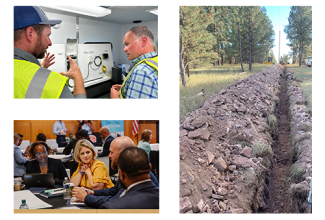Envisioning an Equitable, Inclusive Connected America
Internet For All - Welcome Letter
The Internet is now the essential tool for communication in our modern world. It is essential for access to work, access to education, access to healthcare, and access to public services and justice. And yet today millions of people throughout America remain unconnected.
We have been talking about the digital divide in this country for more than 20 years. Thanks to the Bipartisan Infrastructure Law (BIL), we finally have the resources to do something serious about it.
The BIL provided a nearly $65 billion investment for a simple, but very ambitious, mission: to connect everyone in America to affordable, reliable, high-speed Internet service. At the National Telecommunications and Information Administration (NTIA), we refer to this initiative as “Internet for All,” and we’ve made considerable progress already.
NTIA spent 2022 meeting this historic moment by crafting program rules and policies, engaging with stakeholders, and awarding billions in planning, infrastructure, and adoption and use grants through programs to support states, territories, Tribes, minority-serving higher education institutions, for profit and not-for-profit service providers — including over $1.8 billion awarded to connect Tribal communities that year alone.
Office of Internet Connectivity and Growth (OICG) Report
Access a PDF version of the Report by clicking on the button below.
In 2023, NTIA supported states and territories as they prepared to receive a historic level of federal funding through the Broadband Equity, Access, and Deployment (BEAD) program and to administer previously funded projects. By working with the states, territories and the District of Columbia, NTIA is laying the foundations necessary to ensure that America can successfully close the digital divide.
Implementing the BIL and Consolidated Appropriations Act, 2021 (CAA) programs over the past two years has been both challenging and rewarding. By effectively targeting our resources, partnering with other federal agencies, employing individualized oversight, and engaging with local stakeholders, NTIA and the Office of Internet Connectivity and Growth (OICG) are building upon years of experience and partnerships to lay the strong foundations needed for states, territories, and Tribal governments to deliver on the promise of Internet for All.
Thanks to the foresight of Congress, our country is making an unprecedented investment in connectivity over the next few years, and we are pleased to provide this report detailing the progress we are making to ensure that everyone in America has the connections and the tools they need to thrive in the modern digital economy.
Overview
Since the advent of the Internet age, Americans have struggled to overcome the “digital divide,” the gap between those with and without access to the Internet.
In 1998, the U.S. Department of Commerce’s National Telecommunications and Information Administration (NTIA) identified a “persisting ‘digital divide’” finding that despite the significant growth in computer ownership and usage, the "digital divide" between certain groups of Americans had increased between 1994 and 1997.1 Nearly 30 years later, the Office of Internet Connectivity and Growth (OICG), an office within NTIA, is leading the charge to connect everyone in America to the Internet and close the digital divide.
Access to affordable, reliable, high-speed Internet service is a necessity, and is vital to work, learn, and prosper in the 21st century. As of 2022, approximately one in five, or 24 million, U.S. households do not have a high-speed Internet service connection, preventing them from fully participating in modern life.2 The Infrastructure Investment and Jobs Act, also known as the Bipartisan Infrastructure Law (BIL), committed $65 billion to bring affordable, reliable, high-speed Internet service to everyone in America.3 OICG oversees the administration of $48.2 billion of this historic investment, as well as $1.7 billion in broadband programs funded by the Consolidated Appropriations Act, 2021 (CAA). OICG also fulfils its other duties as outlined in the ACCESS BROADBAND Act, including connecting with communities that need access to high-speed Internet, holding regional workshops across the country to promote broadband access and adoption, and developing training and publications to promote strategies to expand broadband access and adoption in a variety of communities, among other legislatively mandated responsibilities.4
As digital technology has become a necessity of everyday life, the need to provide high-speed Internet for All is imperative. The digital divide continues to be based on race, age, income, location, and other demographic characteristics. OICG is closing the digital divide by strategically deploying its grant programs and working with states and territories to use those funds to address the many unique obstacles to providing affordable, reliable, high-speed Internet service for everyone in America. This report will cover OICG’s efforts throughout 2023 to connect the country and close the digital divide.
About the Report
The ACCESS BROADBAND Act requires OICG to submit to relevant congressional committees and publish on its website an annual report that contains a description of OICG’s work for the previous year and the number of U.S. residents connected to broadband through federal broadband support programs and the Universal Service Fund Program.5 The OICG Annual Report describes the work of OICG, fulfilling the statutory requirement of the ACCESS BROADBAND Act.
The 2023 OICG Annual Report provides an overview of the work accomplished by OICG across its initiatives over the prior calendar year as it administers the BIL and CAA federal broadband grant programs. This is the third report prepared under the requirements of the ACCESS BROADBAND Act.
The ACCESS BROADBAND Act also mandates that OICG report on “how many residents of the United States were provided broadband by which universal service mechanism or which Federal broadband support program,” and include an “estimate of the economic impact of such broadband deployment efforts on local economies, including any effect on small businesses or jobs.”6 NTIA’s forthcoming Federal Broadband Funding Report fulfills the remaining ACCESS BROADBAND Act requirements. Detailed data on broadband investments made by the Federal Communications Commission (FCC) and the rest of the Federal government will be available in NTIA’s forthcoming Federal Broadband Funding Report. This data will also be available as an interactive dashboard on NTIA’s website. The 2022 Report and Dashboard can be found on NTIA’s website.
Agency Overview

The Office of Internet Connectivity and Growth (OICG), which is housed within the Department of Commerce’s National Telecommunications and Information Administration (NTIA), strives to achieve digital equity and ensure universal broadband access. OICG embodies this commitment through four interconnected core pillars: funding broadband infrastructure and digital inclusion efforts; leveraging data to make informed program management decisions; facilitating broad stakeholder coordination to enhance understanding beyond data; and building the capacity of communities to actively shape their connected future. OICG prioritizes data-driven decision-making, employing resources to ensure federal broadband infrastructure grants benefit unserved and underserved areas, as directed by the Bipartisan Infrastructure Law (BIL). OICG furthers the deployment and use of broadband technology, which lays the groundwork for sustainable economic growth, improved education, public safety, health care, and the advancement of other national priorities.

OICG envisions an equitable and inclusive future where everyone in America is connected to affordable, reliable, high-speed Internet service; enabling each person to fully participate in the modern, digital society by accessing opportunities and information only available online.
OICG Pillars
Four interconnected core pillars drive OICG’s initiatives, strategy, and key accomplishments: 1) Fund Broadband Infrastructure and Digital Inclusion Efforts; 2) Leverage Data for Decision Making; 3) Facilitate Interagency, State, Tribal, and Private Sector Coordination; and 4) Build Capacity of Communities.
Fund Broadband Infrastructure and Digital Inclusion Efforts
OICG funds broadband infrastructure and digital inclusion efforts to empower a variety of stakeholders including states, territories, Tribes, unserved and underserved populations, community anchor institutions, and service providers to invest directly in their communities. These funds support tailored approaches to provide infrastructure and access to affordable, reliable, high-speed Internet service. They also support digital inclusion projects and the tools and resources needed for full participation in our 21st century economy and society. OICG also provides eligible entities and subgrantees with technical assistance that supports their participation in NTIA broadband grant programs and success in awarded grant applications. These technical assistance resources include tools, materials, one-to-one and one-to-many direct support, and public-facing tools and resources.
Leverage Data for Decision Making
Using an inclusive and data-driven method, OICG devotes significant resources to ensure that federal dollars are invested wisely. This approach is especially important to ensure adequate investment in unserved and underserved areas. OICG works directly with federal and state partners to coordinate interagency activities and to obtain and share data for grant awards and pending application areas (as appropriate) in common mapping tools, including the FCC’s Broadband Funding Map. These mapping efforts allow federal agencies to identify potential areas of duplication and make informed funding decisions.
Facilitate Interagency, State, Tribal, and Private Sector Coordination
OICG coordinates efforts amongst federal agencies, states, Tribes, and the private sector through information sharing to enhance the availability, adoption, and use of high-speed Internet service. These facilitated interactions can lead to more accurate understandings of where unserved and underserved communities are and how to overcome digital divide barriers in those communities. This coordination is central to a holistic deployment of federal and private resources that address connection deficiencies and close the digital divide.
Build Capacity of Communities
OICG builds the capacity of communities through outreach and communications efforts, including holding regional workshops and local coordination events, publishing tools and guides on effective strategies to expand broadband access and digital equity, and convening stakeholders. OICG continues to provide support to different communities of stakeholders to promote impactful and efficient education and knowledge sharing.
OICG facilitates several cohort groups including the Federal Funding Workstream (FFWS), the State Broadband Leaders Network (SBLN), the Digital Equity Leaders Network (DELN), the Connecting Minority Communities Learning Network (CMC-LN), and the Tribal Broadband Leaders Network (TBLN). OICG also develops technical assistance and informational resources and leads outreach efforts to assist states, territories, and Tribal governments with developing plans to provide affordable, reliable, high-speed Internet service for all.
Introduction to Funding Programs
1 See Falling Through the Net II: New Data on the Digital Divide, (last accessed Feb. 5, 2024).
2 See NTIA blog post “Switched Off: Why Are One in Five U.S. Households Not Online?”
3 Infrastructure Investment and Jobs Act, Pub. L. No. 117–58 (Nov. 15, 2021).
4 Consolidated Appropriations Act, 2021, Pub. L. No. 116-260, Division FF, Title IX, Sec 903(c)(1), (Dec. 27, 2020).
5 See Id.
6 Id.

